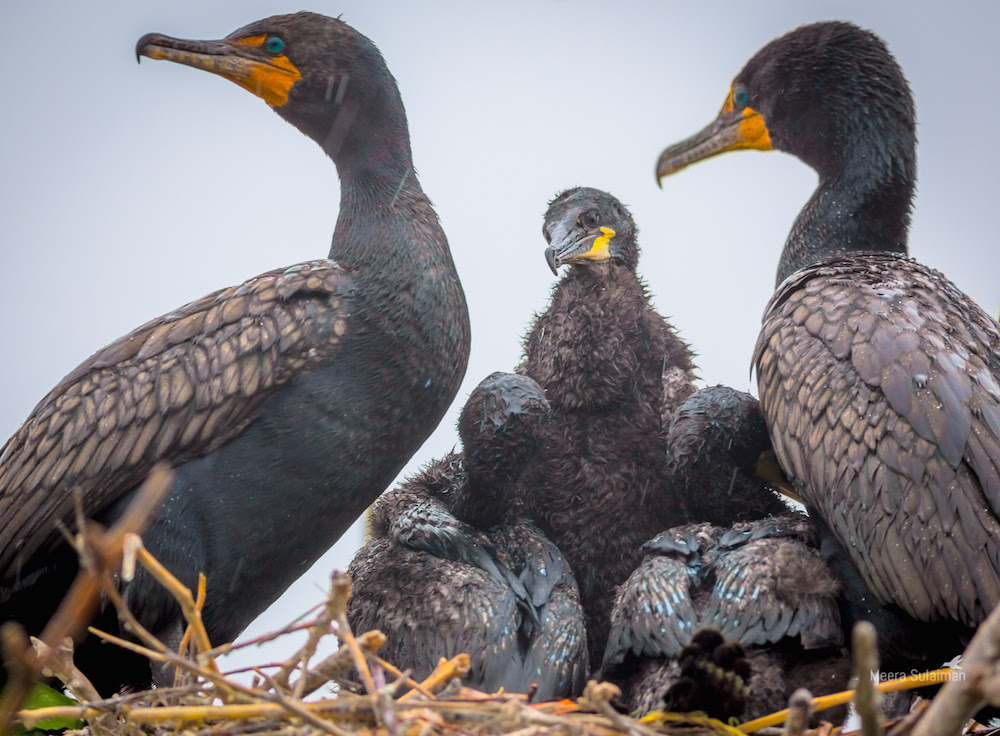Ontario Nature calls on government to abandon plans for cormorant hunt

Unlike many species, it takes both male and female cormorants to raise the young. Shooting one would result in the chicks dying.
From Ontario Nature
Under the guise of “population management,” the Government of Ontario is proposing nothing less than an all-out slaughter of double-crested cormorants, a wild native species. If the government proceeds as it is planning, anyone with a small game hunting license will be able to kill up to 50 birds a day from March 15 until December 31 each year. That’s potentially more than 14,000 birds per hunter, per season – and for no good reason.
The government says it is responding to “concerns expressed by some groups” (commercial fishing industry, property owners) about the impacts of cormorants on fish populations, island forest habitats, aesthetics amd other species. In essence, however, it is about sanctioning the unfettered killing of a wildlife species that some people simply don’t like. Indeed, the government’s response is lacking in any scientific justification or evidence. There is no information about the current population size, no population management target, no rationale for the incredibly high daily bag limit and no plan in place to monitor and assess impacts.
Cormorant populations in the Great Lakes have stabilized or declined slightly since the early 2000s. So what then is the rationale for nine-and-a half months of carnage on our waterways every year? No one is going to eat them. In fact, the government is proposing to amend the Fish and Wildlife Conservation Act so that the cormorants killed can be allowed to spoil, unlike any other game species.
Contrary to wildlife management norms, hunting will be allowed throughout the breeding season and at breeding colonies, likely leading to nest failure, chick starvation, and disruption and mortality of other birds nesting nearby. Collateral damage may include great blue herons, great egrets, black-crowned night-herons, Caspian terns, common terns and great black-backed gulls. According to Bird Studies Canada, “the proposed bag limit of 50 Double-crested Cormorants per day per hunter with no possession limit over a nine and a half month open season is exceptionally high, unsustainable, and without precedent under the Fish and Wildlife Conservation Act for its failure to address the need for population sustainability.”
There are also public safety concerns. Hunters will be permitted to shoot cormorants from stationary boats throughout the open water season – when government conservation officers, boaters, cottagers and other outdoor recreationists are also out on the water.
Here are a few more facts to consider:
-Cormorant populations have rebounded from historic lows in the 1970s, after the species suffered steep declines because of environmental contaminants. Their recovery is widely hailed as a Great Lakes conservation success story.
-Property owners already have recourse, under Section 31 of the Fish and Wildlife Conservation Act, to harass, capture or kill cormorants if they’re causing property damage.
-According to the Canadian Wildlife Service, cormorants feed primarily on small, largely non-commercial, shallow-water fish (e.g., non-native rainbow smelt and alewife). Only a small percentage of their diet consists of “sport fish,” which is one of the excuses given for the hunt.
Sign Ontario Nature’s petition (which goes to the Environmental Registry as a comment)
See also: Peaceful Parks Petition









Leave a Reply